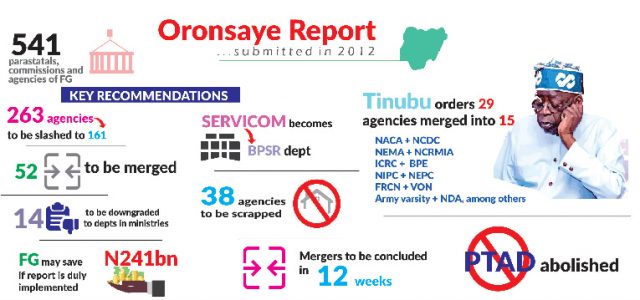
THE vexing 12-year wait to restructure, rationalise, relocate, and scrap the inflated ministries, departments and agencies of the Federal Government is finally over. President Bola Tinubu pressed the button for the downsizing on Monday when the Federal Executive Council gave 12 weeks to implement the Steven Oronsaye panel report. Tinubu has taken a bold decision in Nigeria’s best interests, but this should be the beginning of more reform, particularly the reduction of his bloated cabinet.
At the time of the report in 2012, the Federal Government owned 541 MDAs. A BudgIT report said there are now over 900 MDAs, recklessly created by the National Assembly to satisfy the political whims of lawmakers. The report had recommended that statutory agencies be reduced to 161 from 263 by merging 52, scrapping 38 and relocating 14.
Although the economy was beginning to falter, Goodluck Jonathan, who originally commissioned the assignment and his successor, Muhammadu Buhari, unwisely put it on the shelf to gather dust. This put Tinubu to the test, which he has somehow scaled. His administration has given a timeline of three months for implementation.
The George Akume-led panel is tasked with reducing 29 MDAs with overlapping functions to 15. Among them, the Nigerian Army University will be merged with the Nigerian Defence Academy. This is the right step. Since the Jonathan era, the presidents have been pointlessly creating universities that the government cannot fund. Instead of upgrading the NDA, the transport and the engineering faculties in the existing universities, new universities have been established for the Army, Navy, Air Force, and Police in addition to separate transport and petroleum institutions.
Also affected are the Infrastructure Commission, which is to be subsumed under the Bureau of Public Enterprises, and agencies in agriculture, health, and aviation ministries. The Federal Radio Corporation of Nigeria and the Voice of Nigeria will fuse into one MDA. The Akume panel should add the newly created development commissions and interventionist agencies.
The downsizing is expected to create a leaner government. From the financial point, the Oronsaye report had estimated that the Federal Government will save N241 billion annually by implementing the restructuring. Media reports stated that the annual financial savings is now N862 billion. The savings can be bigger by ensuring that there are no overstaffing, redundancies, and duplication of functions in the restructured MDAs.
Unlike Jonathan and Buhari, Tinubu must not procrastinate on this. On separate occasions, the duo directed government officials to “implement the Oronsaye report.” This makes the people to doubt government pronouncements. Faced with the harsh economic realities, Tinubu must be different.
Still, the MDAs restructuring should just be the beginning of bigger reforms if Tinubu wants to save his government. Consisting of 48 members initially apart from a plethora of special advisers, the President has the largest cabinet in Nigeria’s history. This is unwieldy, adding significant costs to running government.
To show that Tinubu is serious, he must reduce the number of ministries, scrapping the Minister of State portfolio and relinquishing the Petroleum Ministry portfolio as Jonathan did.
Confronted by his country’s woeful economy, Argentina President Javier Milei halved his cabinet from 18 to nine immediately on assuming office in December. He is pressing onward with his target to achieve a 5.0 per cent reduction of public spending to GDP through wider civil service reforms, including stopping crony contracts and handouts. Within nine and a half weeks of coming to power, Milei’s administration turned around a deficit of $1.2 trillion to a budget surplus of $400 billion, the first in 12 years.
Through further determined actions and a strong political will, Tinubu should target similar reforms and downsizing his bloated government to reprieve the gasping economy.
END

Be the first to comment